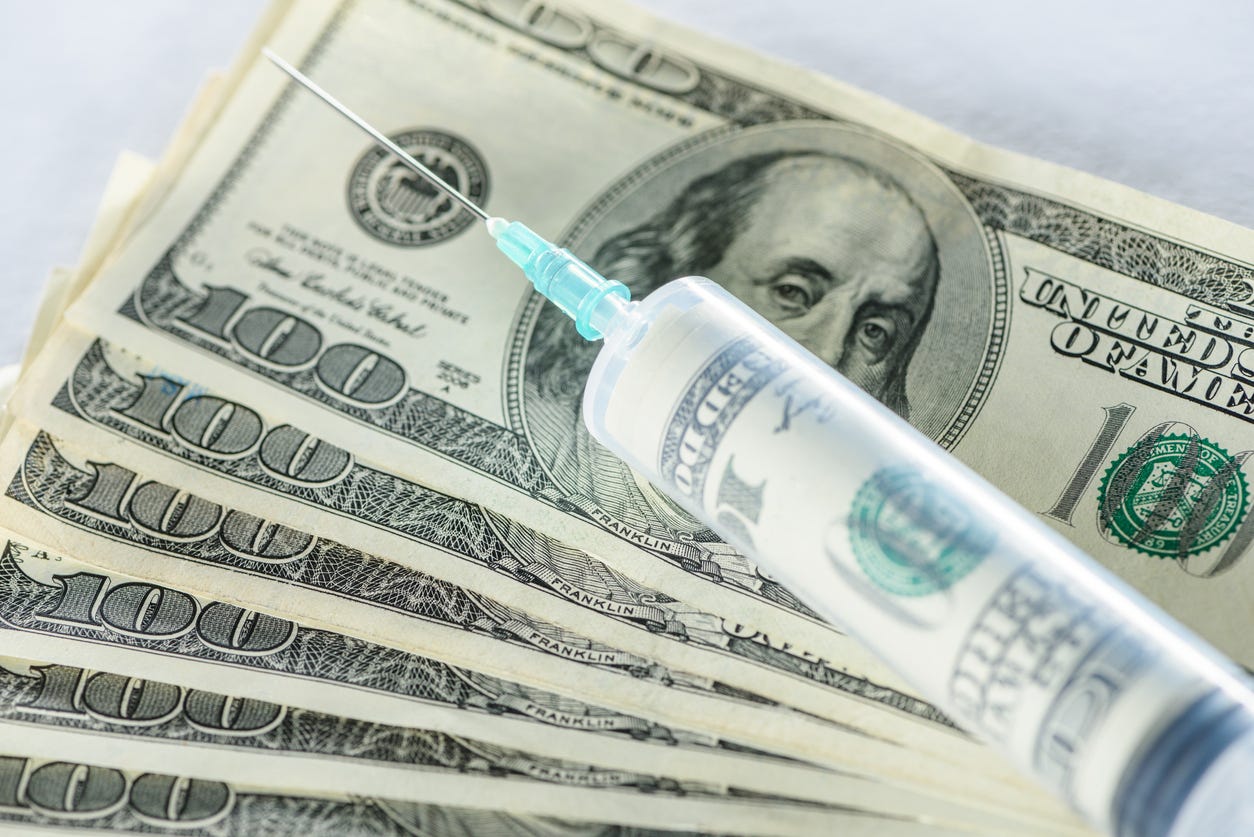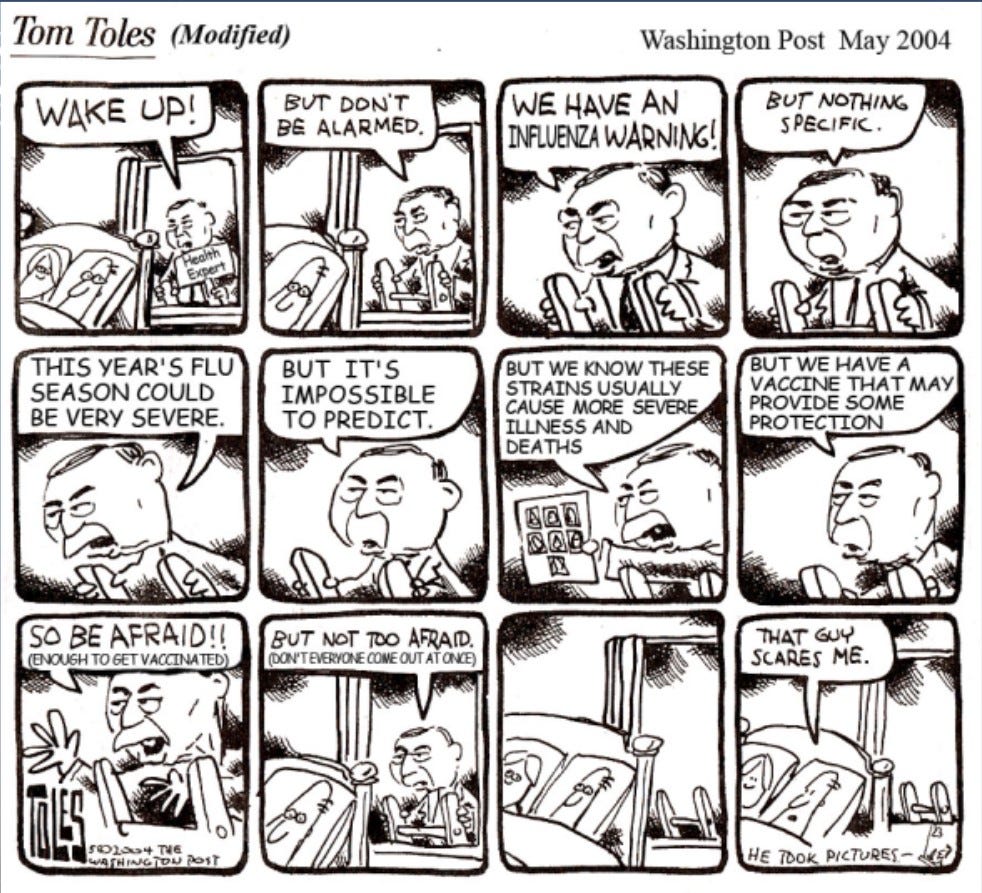Vaccines for health or pharma wealth?
'Most of the vaccines after 1989 were added not for public health reasons but for pharmaceutical profit reasons' - HHS secretary Robert F. Kennedy Jr.
Hepatitis B vaccine for newborns not medically justified
US Secretary of Health and Human Services (HHS) Robert F. Kennedy Jr. (RFK Jr.) recently took to making a video to explain that most of the shots on the vaccine schedule are not medically justified, LifesiteNews journalist Doug Mainwaring reported. Mainwaring included Chief Nerd’s tweet of his video (below).
Rather, RFK Jr. advised, they were added on to provide pharma with more profits.
“Most of the vaccines after 1989 were added not for public health reasons but for pharmaceutical profit reasons,” said Kennedy.
He discussed the Hepatitis B vaccine given to newborns on the first day of life as a glaring example of one that is not medically justified. Hepatitis B is a disease contracted by IV drug users, people who have multiple partners, men who have gay sex, and sex workers. Why would it be routinely given to infants?
Favor for pharma
As it turns out, RFK Jr. explained, the FDA and CDC had asked vaccine manufacturer Merck to develop the vaccine for vulnerable populations. When the company complained that no one was interested in it, the CDC obliged the drug company by putting it on the childhood vaccine schedule, forcing everyone to get it (and forcing the government or insurance companies to pay for it under the Affordable Care Act).
According to Kennedy, Pharmaceutical giant Merck was directed by both the FDA (Food and Drug Administration) and the CDC (Centers for Disease Control and Prevention) to develop the Hepatitis B vaccine for “those vulnerable populations.”
He explained that when those populations showed little interest in the vaccine, “Merck went back to the agencies and said ‘You told us to develop this vaccine, but nobody’s buying it.”
“The CDC said, ‘Don’t worry’” recounted Kennedy, “we’ll just recommend it for children and we’ll force everybody to buy it.”
RFK Jr. acknowledges that a mother can have Hepatitis B but states that all expectant mothers are tested for Hepatitis B; babies of infected mothers can receive the vaccine but there’s no justification for giving it to all babies.
The Hepatitis B vaccine was added for newborns in 1991.
What about the flu shot?
In her 2013 article, CNN health and climate reporter Jen Christensen explained that the decision was made to recommend the flu vaccine for everyone even though it was only 62% effective that year, and even less so for those who are supposed to be most susceptible to the ill effects of the flu.
This year, a year in which the vaccine is supposed to be a good match to the virus, the Centers for Disease Control and Prevention estimates the vaccine is only 62% effective.
And in the segments of the population that are most susceptible to the extreme effects of the flu – like the elderly, who make up the majority of the cases of flu-related deaths – the vaccinations are even less effective.
She quoted the chair of the Department of Preventive Medicine at Vanderbilt University, Dr. William Schaffner, who was also on the national committee that decided to encourage every American to get vaccinated.
“It was debated by the CDC Advisory Committee on Immunization Practices for many years, and the indication for the use of influenza vaccine for an increasing number of groups on a piecemeal basis didn’t make sense,” Schaffner said.
In 2010, the CDC expanded its guidance encouraging the vaccination of vulnerable population groups [which includes infants and children from 6 months to 2 years].
“When you do the back-of-the-envelope calculations (of all the separate groups recommended for vaccination), you are actually already making a recommendation that 75% of the population get it,” Schaffner said. “And when it became apparent the issue of [flu vaccine] shortages was largely put on the back burner, then in 2010, we said, ‘Let’s simplify this and recommended this vaccine for anyone over 6 months old.’”
Get it to prevent sick days
Christensen also pointed to an economic reason for Americans to get vaccinated for the flu—lack of sick days. She explains that in Europe (which at the time had not recommended the vaccine for the entire population) there is a more generous sick leave policy for employees.
There may be another economic reason for more Americans to get vaccinated – one in three U.S. workers get no paid time off when they are sick, according to the Bureau of Labor Statistics. Generally, Europeans have much more generous sick leave policies.
British health officials, she reports, don’t believe the vaccine is even necessary for generally healthy people.
“Although flu can be unpleasant, if you are otherwise healthy, the illness will usually clear up on its own and you will recover within a week,” according to Britain’s National Health Service website.
Favor for pharma, too?
There is another reason, she wrote, that the vaccine may have been recommended for the entire population (a reason Shaffner denied)—the financial benefit to pharma.
Online speculation says the U.S. call for general vaccination is merely a plot by drug companies to make a big profit.
Shaffner says he hears that a lot, but it’s simply not true.
“I have received e-mails after people hear me encourage people to get the influenza vaccine, and they tell me I’m part of some sort of pharmacy company conspiracy and that I’m compromised by them. But influenza vaccines are not real blockbuster money-making drugs,” Shaffner said.
Is Shaffner correct about pharma profits not being a factor in the recommendations?
CDC fearmongers for pharma
In 2004, the CDC helped pharma increase revenue for the flu vaccine after manufacturers, experiencing a slow season, complained to the agency. The CDC’s Acting Director for Media Relations, Glen Nowak, created a PowerPoint titled "Increasing Awareness and Uptake of Influenza Vaccines," featuring a seven-step "Recipe for Fostering Public Interest and High Vaccine Demand." As “Rodef Shalom” 613 (“Pursuers of Peace 613” in Hebrew) reported, Dr. Ken Stollar noted in his letter to the CDC objecting to the PowerPoint, that Nowak made pharma’s role known on National Public Radio.
Preceding the summit, demand had been low early into the 2003 flu season. “At that point, the manufacturers were telling us that they weren’t receiving a lot of orders for vaccine for use in November or even December,” recalled Dr Nowak on National Public Radio. “It really did look like we needed to do something to encourage people to get a flu shot.”
Below are some of the pointers the media and doctors received directly from the CDC on how to manipulate the public by creating unwarranted fear and anxiety so they would run to vaccinate.
Items 3 and 4 of the "Recipe" (page 3, image below) advise using authority figures to predict dire consequences and to create the perception that the flu is causing more severe, even deadly, illness than the year before:
Getting medical experts and public health authorities to “publicly. . . state concern and alarm (and predict dire outcomes) — and urge influenza vaccination”
Publishing media articles and reports saying “that influenza is causing severe illness and/or affecting lots of people, helping foster the perception that many people are susceptible to a bad case of influenza” and “framing of the flu season in terms that motivate behavior (e.g., as ‘very severe,’ ‘more severe than last or past years,’ ‘deadly’)
The section titled: "Implications of the Recipe" (images below) explains the need to create panic among those who don't ordinarily vaccinate.
Fostering demand, particularly among people who don't routinely receive an annual influenza vaccination, requires creating concern, anxiety, and worry. For example:
A perception or sense that many people are falling ill;
A perception or sense that many people are experiencing bad illness;
A perception or sense of vulnerability to contracting and experiencing bad illness.
A scary influenza warning.
Not wanting to leave anything to chance, Nowak included cartoons in the PPT (below) directing the media on just how to do it. The top image is an original Tim Toles "terror warning" cartoon (page 14 in the PPT) and the bottom image is Nowak's "modification," turning it into an "influenza warning" (page 15 in the PT). Nowak wanted readers to be afraid of the flu just enough to get vaccinated, but not too afraid since they don't want everyone coming at once.
So be afraid. But not too afraid.
Vaccines can harm
Hepatitis B for newborns
Unfortunately, the vaccines being unjustly recommended to the American public are not just money makers for pharma but are often harmful to those who get the shots. Physicians for Informed Consent alerted the public to the dangerous amounts of aluminum included in the Hepatitis B vaccine given to newborns with the following tweet.
Parents, did you know? The Hep B vaccine given to newborns contains 250 mcg of aluminum—that’s 75 times the maximum safe limit for a 7.3-pound infant’s bloodstream.
Since vaccines bypass the gastric system and go straight to the bloodstream, the dangers of injected aluminum are much greater than ingested aluminum. As Rodef Shalom 613 reported, these are some of the adverse effects of aluminum:
Aluminum:
Inhibits over 200 important biologically important functions
Interferes with the body’s use of calcium, magnesium, Vitamin K, and hydrogen
Induces DNA damage
Interrupts bone formation resulting in spontaneous fractures
Can accumulate in the body when bypassing the gastrointestinal barrier (as with vaccines), resulting in aluminum overload
Negatively impacts the male reproductive system
Aluminum has been found to cause severe and chronic illness including:
Encephalopathy (brain disease), dementia and impaired neurological development, osteopenia (low bone density), and osteomalacia (softening of bones to do impaired bone metabolism)
Macrophagic myofasciitis (MMF)
Allergy to aluminum
Aluminum induced bone disease
Many autoimmune/inflammatory diseases
Autism; aluminum is found in excessive amounts in the brains of autistic individuals
Epilepsy
Concurrent exposure to both aluminum and mercury may have added dangers on the aluminum in vaccines explaining that they are toxic and neurotoxic.
Rodef Shalom 613 further explained that scientists who participated in the May 2000 National Vaccine Program Office of the Department of Health and Human Services “Workshop on Aluminum in Vaccines” couldn’t figure out how the FDA determined a safe level for injected aluminum, as per the following exchange from the workshop transcript:
“Dr. Gerber: Michael Gerber, National Institutes of Health.
“Norman, the standard of .85 milligrams of aluminum per dose [allowable in each vaccine] set forth in the Code of Federal Regulations, can you tell us where that came from and how that was determined? "
Dr. Baylor: “Unfortunately, I could not. I mean, We have been trying to figure that out. We have been trying to figure that out as far as going back in the historical records and determining how they came up with that and going back to the preamble to the regulations. We just have been unsuccessful with that but we are still trying to figure that out.”
They gave it a pass, however, at the behest of the WHO’s participant, Dr. Clements, who shared that it’s easier to use aluminum than mercury (thimerosal in vaccines) because parents don’t consider aluminum toxic.
The public is very much concerned with mercury and it is not so surprising that thimerosal with its mercury generated so much interest. Aluminum is not perceived, I believe, by the public a dangerous metal and, therefore, we are in a much more comfortable wicket in terms of defending its presence in vaccines. . . .
I think the public does have a right to know what is going on. . . . We must share what we know. And if we do not say what we know then it will be made up and we need to get our point across about vaccine safety from a strong point of view with good communications.
So, in wrapping up … my conclusions would be that these vaccines that have had aluminum adjuvants in them have had an excellent track record of safety and efficacy for over 70 years.
Flu vaccine
The flu vaccine is also not without its harms. Igor Chudov reported on a study comparing U.S. veterans hospitalized with COVID-19 or the flu who had tested positive for SARS-COV2 either 2 days before or 10 days after hospitalization and their vaccination status. The study, published in JAMA in April 2023, found that far fewer veterans who didn’t receive any vaccine were hospitalized than those who had received either the flu or COVID-19 vaccines. He included the following table from the paper:
Chudov explained the results, noting that the percentage of patients hospitalized with COVID who were vaccinated against the flu was almost identical to the percentage of patients hospitalized with flu who were vaccinated against the flu.
Take a look at the line underlined in BLUE (last line). 64% of patients hospitalized with COVID were vaccinated against the flu. 63% of patients hospitalized with flu were vaccinated against the flu.
We know that the influenza vaccine does not prevent Covid hospitalizations. But if the influenza vaccine prevented influenza hospitalizations, there would be fewer influenza-vaccinated people hospitalized for influenza than influenza-vaccinated people hospitalized for Covid.
If the influenza vaccine were 100% effective at preventing hospitalization with influenza, in the table above, we would have ZERO patients who had an influenza vaccine hospitalized for influenza. Instead of zero, 63% of people hospitalized for influenza are vaccinated for influenza, the same as the percentage of influenza-vaccinated people among Covid hospitalizations.
A previous study by the Department of Defense, reviewed by the Disabled Veterans organization showed that service members who had the flu shot increased their risk of coronavirus by 36%.
A recent military study shows military personnel evaluated who received the flu vaccine were at 36 percent increased risk for coronavirus with only a small benefit against catching influenza.
Examining noninfluenza viruses specifically, the odds of both coronavirus and human metapneumovirus in vaccinated individuals were significantly higher when compared to unvaccinated individuals.
Disabled Veterans quoted from the study, explaining its finding that overcoming a natural flu infection helps the body fight off other viruses. However, those vaccinated for the flu lost that ability due to viral interference.
Paraphrasing, the study highlights the value of the human body’s ability to fight against viruses. Apparently, by contracting influenza, the body naturally “may reduce the risk of non-influenza respiratory viruses…”
Due to the flu vaccine’s “interference” with the naturally occurring biological process, there may be an increased risk of contracting non-influenza viruses:
“While influenza vaccination offers protection against influenza, natural influenza infection may reduce the risk of non-influenza respiratory viruses by providing temporary, non-specific immunity against these viruses. On the other hand, recently published studies have described the phenomenon of vaccine-associated virus interference; that is, vaccinated individuals may be at increased risk for other respiratory viruses because they do not receive the non-specific immunity associated with natural infection.”
Just two of how many?
These are only two of the regularly scheduled vaccines Americans are recommended to take whose purpose seems to be to enrich pharma even though they harm the vaccinated. How many other vaccines fall into this category and what are the long-term consequences?












